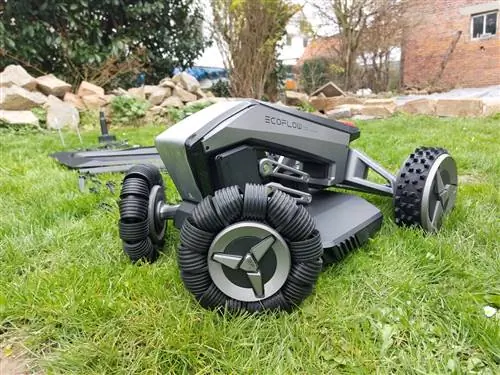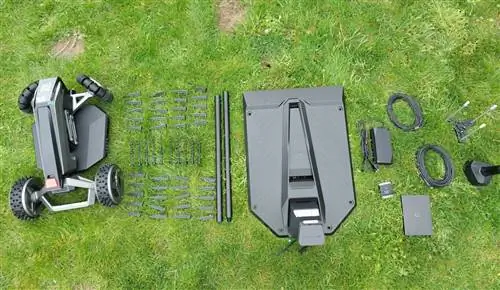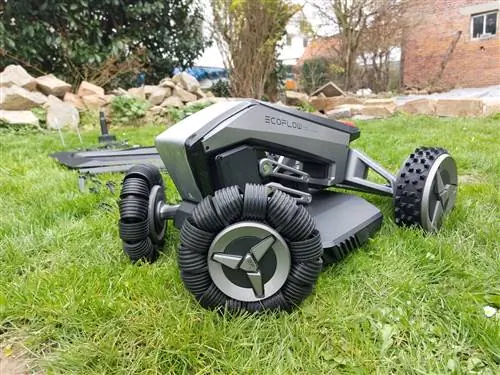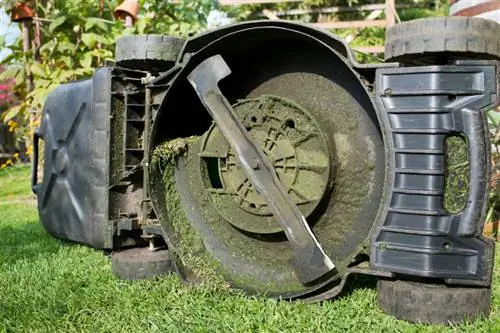- Author admin [email protected].
- Public 2023-12-24 06:09.
- Last modified 2025-06-01 06:02.
The EcoFlow Blade promises to revolutionize gardening by not only mowing the lawn but also collecting leaves. In our test report we examine the question of whether this innovative product delivers what it promises.

Manufacturer information
At first glance, the Blade is reminiscent of a Mars rover. But it quickly becomes clear that its unusual design is not only visually appealing, but also functional. The large front wheels with an angle of 45° allow for better overcoming obstacles and easier maneuvering in tight spaces. This sets the mower apart from the competition. However, EcoFlow offers four other outstanding features:
- Virtual boundary: Thanks to a GNSS receiver for navigation, laying a physical boundary wire is not necessary.
- Route planning: Highly efficient mowing through a planned route, which means that areas are neither mowed twice nor missed.
- Obstacle detection: Small obstacles (such as tree roots) can be driven over and larger obstacles (e.g. garden chairs) can be avoided without contact.
- Leaf pickup: With an additional collecting basket, the mower can pick up leaves independently.
| Product Specifications | |
|---|---|
| Weight | 12, 3 kg |
| Dimensions | 66 x 44 x 31 cm |
| Loading time | 130 min |
| Operating time | 240 min |
| Performance | 300 m²/h |
| Cut length | 20 to 76 mm |
| Cutting width | 26 cm |
| Max. Mowing area | up to 3000 m² |
| Operating limits | 0 to 45 °C |
| Stock Limits | - 20 to 60 °C |
Unpacking & Installation
The Blade is delivered safely packed in a large box. With a weight of 12.3 kg, it is heavier than expected, which surprises us in a positive way because we are hoping for better traction from it.

Mower, station, receiver, nails, cables are included in the included accessories
The assembly is very easy. Although instructions are included, we installed the app and followed all the steps there. The material used is high quality and well made, making it comfortable to set up. There are no sharp edges and the connectors and cables are well labeled, making installation intuitive.
Before using, the receiver and charging station must be placed in the garden and connected to the power supply. The manufacturer also offers a large power bank that enables an isolated solution for the charging station. In our case, however, we used electricity available directly in the garden.
Setting up the mowing area
Next we set up the mowing area. We establish a Bluetooth connection to the lawnmower via the app and follow the instructions in the setup wizard. Using the arrow keys displayed on the smartphone, we control the mower along the edges of the mowing area until it is completely circled. Permanent obstacles such as a pond or a tree can be entered in the same way. We have defined an area with freshly sown lawn as a restricted area to prevent the mower from driving there.
If the garden consists of several separate areas, it is also possible to create a second garden in the app. In this case, a path must also be defined that the mower uses to travel between the areas.
Setting up the mowing areas went smoothly. To test customer support, we contacted the manufacturer and were pleasantly surprised when we quickly reached a real contact person in the chat.
Challenges
As already mentioned at the beginning, the Blade stands out strongly from other robotic lawn mowers in some aspects. In order to test these features in detail, we have prepared a variety of challenges.

Route planning
Thanks to the mapping and the GNSS antenna, the robotic lawnmower is able to recognize its position on the route and follow a predetermined route. This sets it apart from other machines that use more random mowing patterns, which means it should be able to cover the entire area with each use.
Our test showed that the mower creates a route and follows it precisely. At the beginning of the video you can see him turning to change the route. The specified area is mown perfectly and left-out areas are reliably left out. When it comes to the edges, we found that the Blade drives on sight. Due to the demanding test site, the edges are not always perfectly cut. However, we are optimistic that he will achieve excellent results on easier terrain.
Review: The biggest advantage is the lack of need for physical boundary wires. This means that mowing and restricted areas can be spontaneously redefined without having to dig up the garden. As a compromise, the system requires a receiver, which, however, could be integrated unobtrusively into the garden. The intelligent route guidance gives you the good feeling that the mower is doing its job 100% without traveling unnecessarily long distances.
Avoiding large obstacles
Using a LiDAR sensor and a camera, the mower creates a three-dimensional map of the surrounding area. This allows obstacles along the planned route to be detected and avoided in real time. This distinguishes the Blade from many conventional models that do not always work correctly with ultrasonic and shock sensors.
During our tests, the robotic lawnmower recognized and avoided all larger objects such as toys or garden chairs without any problems. After detouring, it returns to the originally planned route. A scene about this is documented in the video (0min57s).
Assessment: Temporary obstacles are mastered excellently by the robot without creating large unmown areas.
Climbing over small obstacles
Thanks to the large front wheels with a diameter of 20 cm and good traction, the Blade should be able to overcome small obstacles up to 4 cm high.
To test this function, we simulated a tree root with a weighted wooden slat and let the mower drive over it. As can be seen in the video (1min50s), the obstacle is crossed without any problems. During the tests, we observed that for various objects that are in the limit range of +/- 4 cm, the decision as to whether the object should be driven around or driven over is made depending on the situation.
Assessment: Overcoming obstacles works well. Sometimes it is difficult to understand why an obstacle is climbed over or avoided. However, in no case was there any damage.
Abort in case of splashing water
The mower is splash-proof (IPX5) and equipped with a rain sensor. In rainy weather, the mowing process should be stopped and the device returned to the charging station.
To simulate precipitation, we artificially irrigated the mower. It didn't react to the first drops of water, but as the humidity increased it drove away from its route and towards the charging station (see video 2min06s). The cancellation is displayed in the app and the remaining unmown area is highlighted in color.
Rating: The rain sensor works reliably.
Pick up leaves
According to the manufacturer, the Blade is the world's first lawn sweeping robot. The camera and sensors are intended to detect and collect leaves and pine cones before and after mowing. The sweeping set is available separately.
Unfortunately, at the time of our test, the sweeping function was not yet activated in the app. We will report on the results here in due course.
Conclusion
Overall, the Blade robotic lawnmower impressed us. The mowing performance is excellent, and although the device can be heard during use, it is not perceived as a nuisance. Obstacle detection offers additional safety, and the virtual area boundary represents a major advantage over conventional models.
Despite the uneven test terrain, which was characterized by molehills, the Blade mastered the challenges confidently. The well-thought-out weight distribution and traction of the device play a crucial role here.
In our opinion, the Blade robotic lawnmower currently offers the best range of functions on the market. For those who don't want to make any compromises when it comes to lawn care, this device is the ideal choice. Thanks to the very large mowing range (20 - 76mm) and the flexible selection of areas, the Blade is suitable for gardens with closely mown areas as well as for natural gardens with unmown flower islands.
A potentially deterrent factor could be the high price of RRP 2,999 euros. Additionally, for some users, installing a GNSS receiver may be less appealing than using a physical boundary wire, although the receiver provides additional flexibility.
Note: The manufacturer provided us with the product for testing. Nevertheless, our research, the test structure and the evaluation were not influenced in any way.
If you follow the link and make a purchase, we will receive a commission at no extra cost to you






